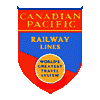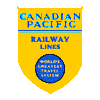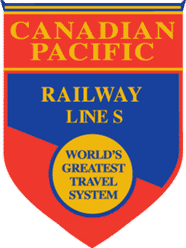







This World Wide Web article was created from John Loye's article in the Railway and Locomotive Historical Society Bulletin Number 28 (May, 1932),
pages 51-54. Links to applicable photos have been added to the author's text. The original document is quoted here by OKthePK website under the
provisions in Section 29 of the Canadian Copyright Modernization Act of 2011.

 company, and many other enterprises that are quite outside that of actual
railroading.
company, and many other enterprises that are quite outside that of actual
railroading.
The Canadian Pacific ocean steamship lines on the Atlantic and Pacific are world renowned, and in addition, the company has a fleet on the Great
Lakes. For long the Canadian Pacific Railway stood predominant and unrivalled in its domain, Canada, but the colossal merger of 1923 which produced
the Canadian National Railways, put another organization in the field, one which emulates the C.P.R. and which girds the Dominion with three thousand
miles of steel from sea to sea and that operates ships and hotels and a business as wide and varied as that of the Canadian Pacific
Railway.
The First Canadian Pacific Proposal - The first serious suggestion for a transcontinental line of railway from Halifax to the Puget Sound
appeared in the newspapers of Lower Canada in 1829, from correspondents whose names have not been left to us, and from a civil engineer named
McTaggart. Even at this early time they were not treated as fanciful and never ceased to interest the public mind in succeeding years. In 1849, one
Carmichael Smyth published the plans of a scheme to the effect of linking the oceans by rail. He proposed to utilize convict labour in its
construction in order to reduce the expense. He estimated its length at 4,000 odd miles and the cost of £24,000 per mile. The Hon.
Joseph Howe , speaking
at a meeting in Halifax in 1851, stated he hoped to see the day when he would be able to travel from Halifax to the Pacific in six days. In the same
year Allan McDougal proposed a railway from the head of Lake Superior to the Pacific Ocean, with a land grant sixty miles wide along the route to the
company undertaking the construction. In 1858 the North West Transportation & Railway Company was incorporated, contemplating a system of rail and
water lines from Fort William to Vancouver Inlet. This company never emerged beyond the incorporation state. Nevertheless, we find in these premature
gestures the genesis of our present Canadian Pacific Railway, which realized, in 1885 the dream of 1829, Smyth's plan of 1849, Howe's wish and hope of
1851, and the abortive attempt of 1858. So much for the foresight of the men of by-gone days. Their ambition to realize was thwarted by the fact that
fate had ordained them to have been born too soon.
, speaking
at a meeting in Halifax in 1851, stated he hoped to see the day when he would be able to travel from Halifax to the Pacific in six days. In the same
year Allan McDougal proposed a railway from the head of Lake Superior to the Pacific Ocean, with a land grant sixty miles wide along the route to the
company undertaking the construction. In 1858 the North West Transportation & Railway Company was incorporated, contemplating a system of rail and
water lines from Fort William to Vancouver Inlet. This company never emerged beyond the incorporation state. Nevertheless, we find in these premature
gestures the genesis of our present Canadian Pacific Railway, which realized, in 1885 the dream of 1829, Smyth's plan of 1849, Howe's wish and hope of
1851, and the abortive attempt of 1858. So much for the foresight of the men of by-gone days. Their ambition to realize was thwarted by the fact that
fate had ordained them to have been born too soon.
The Canadian Pacific Realized - The romance that invests the story of the passage of the Rocky Mountains by the railways of this continent is not to
be met with in the history of any other land. North America produced a stage-setting, so to speak, more grand and inspiring, more romantic and
thrilling, and above all, more picturesque than ever to be found elsewhere on this planet.
by the railways of this continent is not to
be met with in the history of any other land. North America produced a stage-setting, so to speak, more grand and inspiring, more romantic and
thrilling, and above all, more picturesque than ever to be found elsewhere on this planet.
The atmosphere of the great west of America, its vastness, the barrier of the rocky ranges, and the lure of the ocean that lay beyond, the
indomitable race of red men who disputed entry of the white man on their wild preserves, and the varied type and character of the men who crossed the river and
the plain and pierced the mountains
who disputed entry of the white man on their wild preserves, and the varied type and character of the men who crossed the river and
the plain and pierced the mountains with their strands of steel. All the scenic, tragic, heroic, and poetic elements of western American adventure enlivened and
embellished the story of the building of the Canadian Pacific Railway. Men of the same mettle as those who first linked the oceans at Promontory
Point, led the way through the virgin fastness, or under the towering peaks of Stephen and Kanmore to a successful joining of the rails at
Craigellachie on November 7, 1885.
with their strands of steel. All the scenic, tragic, heroic, and poetic elements of western American adventure enlivened and
embellished the story of the building of the Canadian Pacific Railway. Men of the same mettle as those who first linked the oceans at Promontory
Point, led the way through the virgin fastness, or under the towering peaks of Stephen and Kanmore to a successful joining of the rails at
Craigellachie on November 7, 1885.
The red man rose against the invasion of the befunneled iron monster but was subdued. The ocean was attained and the Canadian Pacific Railway took
its place among the wonders of the world.
The Origin of the Canadian Pacific Railway - The Canadian Pacific, like the Grand Trunk, had its origin in certain existing lines in Eastern Canada. As we have shown, the idea of a Canadian transcontinental railway had been in the public mind for long, even before the Confederation. The foundation of the great political structure of the federated provinces and territories of Canada, which were erected into a self-governing Dominion in 1867, rested upon a guarantee to the people of British Columbia that their isolated province should be linked to the East, by railroad.

 , a
Roman Catholic priest, interested promoters in building of the Northern Colonization Railroad, a line designed to open to colonization the regions to
the north of Montreal. South of the St. Lawrence, the South Eastern Railway had been built from a point at Longueil, opposite Montreal, to the Vermont
State line and east and west from its main trunk.
, a
Roman Catholic priest, interested promoters in building of the Northern Colonization Railroad, a line designed to open to colonization the regions to
the north of Montreal. South of the St. Lawrence, the South Eastern Railway had been built from a point at Longueil, opposite Montreal, to the Vermont
State line and east and west from its main trunk.
When the government at last set its hand to the enormous undertaking, it was with a view of consolidating the aforesaid lines to begin with and
then to build westward. On this basis the Canadian Pacific Railway was incorporated in 1881, but not until the Government finally relinquished its
interest to this private corporation.
First Planned to Pass Through the United States - The new company drew heavily on the railway genius of American lines to assist in its
achieving its vast design. The building of the road was done under the guidance of William Van Horne, a native of Illinois.
of the road was done under the guidance of William Van Horne, a native of Illinois.
The first proposition was to lay the rails through central Ontario, Michigan, Illinois, Wisconsin, Minnesota, and there enter Manitoba. The astute
Van Horne decided to strike through the wild land north of Lake Superior and keep the line within Canadian territory. On the other hand, he
recommended passing through the State of Maine to reach the terminus at St. John, New Brunswick. This was done for the same practical reasons that
prompted the British Government experts to advise the St. Lawrence & Atlantic Railroad in 1845, to aim for Portland, Maine, instead of making the
great detour around northern Maine and into Nova Scotia or New Brunswick in order to reach the Atlantic seaboard.
The Achievement - On the 7th of November, 1885, the last spike was driven by Sir Donald Smith, later Lord Strathcona, at Craigellachie, British Columbia, 2,553 miles from Montreal, and 351 miles from Vancouver. The monumental undertaking stood at last achieved.
The celebration attending the driving of the last spike on transcontinental lines had always been elaborate and expensive. The admitted cost of the ceremony on the Northern Pacific Railroad was US$175,000 but it was probably more. In Canada they managed it differently!
"The last spike," said General Manager Van Horne, "will be just as good an iron one as there is between Montreal and Vancouver. Anyone who wants to see it driven will have to pay full fare."
Under these terms the party that witnessed this historic event was limited to a few railroad
officials and the workmen who finished the job. There were no speeches, no
banquet, in fact nothing, and when Mr. Smith had delivered the last blow he threw down the maul and then the little party went fishing!
and the workmen who finished the job. There were no speeches, no
banquet, in fact nothing, and when Mr. Smith had delivered the last blow he threw down the maul and then the little party went fishing!
The outstanding figures in the organization of the Canadian Pacific Railway were, James J.
Hill , Donald A.
Smith
, Donald A.
Smith , George
Stephen
, George
Stephen , and William
Van Horne
, and William
Van Horne . James J. Hill disassociated himself from the enterprise when Van
Horne resolved to lay the rails north of Lake Superior. James J. Hill was later to become the "Empire Builder" in the American Northwest,
but it was Hill who recommended Van Horne to Messrs. Stephen and Smith because of Van Horne's constructive and executive ability while connected with
the Chicago, Milwaukee, & St. Paul Railroad. Van Horne in turn recommended Thomas
Shaughnessey
. James J. Hill disassociated himself from the enterprise when Van
Horne resolved to lay the rails north of Lake Superior. James J. Hill was later to become the "Empire Builder" in the American Northwest,
but it was Hill who recommended Van Horne to Messrs. Stephen and Smith because of Van Horne's constructive and executive ability while connected with
the Chicago, Milwaukee, & St. Paul Railroad. Van Horne in turn recommended Thomas
Shaughnessey , of the same company, to the C.P.R. directorate.
, of the same company, to the C.P.R. directorate.
George Stephen became the first President of the C.P.R. 1881-1888, and when he retired he went to England to live. He was raised to the Peerage as Lord Mount Stephen. He was succeeded by Sir William Van Horne, upon whom knighthood had been conferred. He retired in 1897 to be succeeded by Sir Thomas Shaughnessey, who in addition to receiving knighthood, was later raised to the Peerage as Baron Shaughnessey. Smith was knighted and eventually raised to the Peerage becoming Baron Strathcona and Mount Royal.
All have long since passed from the scene and the destinies of the giant organization are now in the hands of men who were children when its
heralding whistle first rang through the ravines of the Rockies high.
The Jubilee Locomotive - A new high-speed passenger locomotive with a 4-4-4 wheel arrangement which entered service was named
Jubilee in honour of
the fiftieth anniversary of transcontinental passenger service on the CPR. These diminutive locomotives were equipped with large, eighty-inch diameter
driving wheels with low-friction roller bearings and a boiler that operated at 300 psi (pounds per square inch), higher than any other CPR locomotive
except number 8000. Intended for high-speed runs between cities, number 3001 was assigned in September 1936 to a new passenger express running between
Edmonton and Calgary, with a train named the Chinook, after the warm dry winds encountered in the region. Stylized name plates were mounted on the
sides of the boiler jacket near the front of the smokebox, and with the new curved-sided cars, the train cut nearly an hour off the schedule of
regular Calgary/Edmonton trains.
in honour of
the fiftieth anniversary of transcontinental passenger service on the CPR. These diminutive locomotives were equipped with large, eighty-inch diameter
driving wheels with low-friction roller bearings and a boiler that operated at 300 psi (pounds per square inch), higher than any other CPR locomotive
except number 8000. Intended for high-speed runs between cities, number 3001 was assigned in September 1936 to a new passenger express running between
Edmonton and Calgary, with a train named the Chinook, after the warm dry winds encountered in the region. Stylized name plates were mounted on the
sides of the boiler jacket near the front of the smokebox, and with the new curved-sided cars, the train cut nearly an hour off the schedule of
regular Calgary/Edmonton trains.